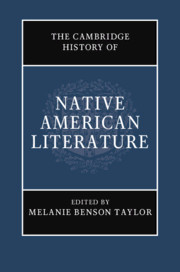Book contents
- The Cambridge History of Native American Literature
- The Cambridge History of Native American Literature
- Copyright page
- Contents
- Figures
- Contributors
- Introduction: What Was Native American Literature?
- Part I Traces and Removals (Pre-1870s)
- Part II Assimilation and Modernity (1879–1967)
- 7 The Multiplicity of Early American Indian Poetry
- 8 Native American Literature in the 1930s
- 9 Black-Indian Literature under Jim Crow
- 10 Transatlantic Modernity and Native Performance
- 11 American Indian Literature and Post-Revolutionary Mexico
- 12 I Kū Mau Mau (Standing Together): Native Hawaiian Literary Politics
- 13 Native Women’s Writing and Law
- Part III Native American Renaissance (Post-1960s)
- Part IV Visions and Revisions: 21st-Century Prospects
- Index
- References
8 - Native American Literature in the 1930s
from Part II - Assimilation and Modernity (1879–1967)
Published online by Cambridge University Press: 18 September 2020
- The Cambridge History of Native American Literature
- The Cambridge History of Native American Literature
- Copyright page
- Contents
- Figures
- Contributors
- Introduction: What Was Native American Literature?
- Part I Traces and Removals (Pre-1870s)
- Part II Assimilation and Modernity (1879–1967)
- 7 The Multiplicity of Early American Indian Poetry
- 8 Native American Literature in the 1930s
- 9 Black-Indian Literature under Jim Crow
- 10 Transatlantic Modernity and Native Performance
- 11 American Indian Literature and Post-Revolutionary Mexico
- 12 I Kū Mau Mau (Standing Together): Native Hawaiian Literary Politics
- 13 Native Women’s Writing and Law
- Part III Native American Renaissance (Post-1960s)
- Part IV Visions and Revisions: 21st-Century Prospects
- Index
- References
Summary
Modernity is often defined as the category that by definition excludes Indigenous people. We could say the same for the modernism, the cultural movement that came into being precisely as a modality of reimaging the future. This essay explores how reimagining Native Americans was not only central for writers during what Michael Denning refers to as the "third wave of modernism" from the late 1920s to the Cold War, but also how Native American modernists imagined themselves within the new emergent forms of modernity. Modernist Native American writers John Joseph Mathews’ and D'Arcy McNickle's touchstone novels, Sundown and The Surrounded, deployed many of the generic tropes of modernism: alienation, hybrid forms, ambiguity, and unreliable narration to express an ambivalence about an emergent modernity. Rather than read the Indigenous as "outside" of modernity, Mathews and McNickle serve to remind us of how Native American modernists complexly engaged with the emergent possibilities of modernist futuricity.
Keywords
- Type
- Chapter
- Information
- The Cambridge History of Native American Literature , pp. 149 - 163Publisher: Cambridge University PressPrint publication year: 2020



